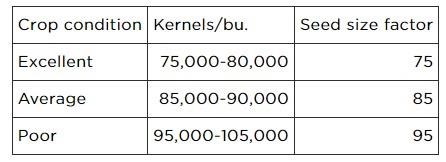By Zachary Larson
A tried and true method of estimating corn grain yields is the yield component method. This method estimates the number of corn kernels per acre and uses an adjustment factor to convert the number of kernels into bushels per acre. This method can generally be used from the milk (R3) stage or later. Estimating at earlier stages should be avoided as there is still potential for kernel abortion.
When sampling in a field, the more samples you take, the more accurate your estimates typically are. Taking estimates from three points in a field is generally a good start. However, more may be needed if a field is extremely variable in crop condition. When sampling, avoid end and border rows as well as extremely high and low yielding areas unless they represent a large portion of the field. Sampling the very small areas to capture the ‘average’ of a field tends to throw the estimates off.
At each sampling point perform the following:
Step 1: Measure off the length of a single row equal to 1/1,000th acre using Table 1. If you are taking multiple measurements, it is best to use a pre-cut length of rope that can be quickly attached to a corn stalk to speed up the measurement process.
Table 1. Sampling length for common row spacings. For other spacings, divide 43.45 by the row spacing, measured in feet. Results will be in tenths of a foot; to covert tenths to inches multiply by 12.
Click here to view Table 1 from Farmdocdaily
Step 2: Count the number of harvestable ears on the plants in the 1/1000th acre of row. Don’t count those that cannot be picked up by the combine header.
Step 3: Select at least 3 areas from the sample area. To avoid bias, use a preset sequence, such as every 5th, 10th and 15th ear. To increase accuracy, more than 3 ears can be sampled. Avoid overly short or odd ears by moving to the next ear, unless they accurately represent the sample area.
Step 4: Count the number of kernel rows and the average length of rows and multiply the two to get the number of kernels per ear. Don't count the extreme butt or tip kernels but begin and end where there are a complete number of rows around the cob (Figure 1). If kernel numbers per row are uneven among the rows of an ear, estimate an average value for kernel number per row. Average the kernels per ear at each sampling point.
Figure 1. When counting kernels on a cob, do not count those at the tip and those that don’t form a full ring or rows at the butt.
Step 5: Estimate the yield at each sample point by multiplying the number of ears per 1/1000th acre of row (Step 2) by the average number of kernels per ear (Step 4). Next, divide that result by the seed size factor (Table 2), which is the number of kernels in a bushel, to obtain the estimate in bushels. Finally, average the calculated yields from all of the sample points to get an estimate for the entire field.

Determining the seed size factor is one of the most subjective parts of estimating corn yield. Kernel weight from year to year for the same hybrid can vary by 20,000 kernels per bushel or more due to differences in growing seasons and conditions during grain fill (Figure 2). Sampling during the dent to black layer stage will increase the accuracy of seed size factor estimates over sampling at the milk or dough stages. You could compare your estimate to the final count by coming back to the field once the crop hits black layer and determining the number of kernels in 25 grams at 15% moisture to get the thousands of kernels per bushel. A more pragmatic approach is to estimate yield at an upper and lower value ‘guess’ of seed size factor and use those numbers to estimate a potential yield range for the field.

Figure 2. The ear on the left has relatively small kernel size and a seed size factor between 95-105 should be used. The ear on the right is more typical and a factor of 85-90 should be used.
Ultimately, the yield component method is only a pre-harvest estimate of yield and it is best used to make some broad comparisons. In most cases, this method probably gets you within 20 bushels of the actual yield. Also, note that this method was developed in the Midwest. Here in Pennsylvania where fields are often smaller and bordered by woods, our edges comprise a larger percentage of the field area and usually have a sizable about of wildlife damage. In those cases, the edges bring the whole field yield down, and most estimates I see are more likely to be high than low.
While it’s still true that the crop isn’t done until it’s in the bin, using the methods above can put you in the right ballpark for assessing what has happened this year and what you should do next year. A few quick trips to the field and counts now may help you figure out what to expect later.